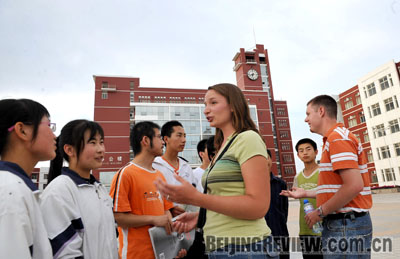|

INTERNATIONAL VISION: Teachers from the United States talk to students from Liupanshan
Senior High School, which offers free education and accommodations to poor students
August 14 was registration day at Liupanshan Senior High School (Liupanshan SHS). Ma Li, a 16-year-old student from the Hui ethnic group, was one of the smart newcomers to the high-quality school, which is only open to good students from the poverty-stricken central and southern mountainous areas of Ningxia Hui Autonomous Region.
Ma comes from Xialiushui Village in Tongxin County, one of the poorest counties of China, and is the youngest of four children in his family. "I had to study hard to be admitted by this high school, because my family cannot afford the high tuition fees in other schools," said Ma. His parents borrowed money to send one of his sisters to university.
The high school is a dream for many poor students. "If you can study here, it means you are already 50 percent of the way to university," he said.
The school is named after the 3,000-meter-high Liupanshan Mountain, which lies in the south of Ningxia. It is one of the poorest areas in the region and home to many ethnic minorities. The school is located in the very center of Yinchuan City, capital of Ningxia.
Established in 2003, the school is funded by the local government and provides free education and accommodations. In addition, it gives each student 1,000 yuan ($146) a year, and provides travel allowances. It is unique among senior high schools in China and meets high educational standards. More students from Liupanshan SHS go on to university than from any other school in Ningxia.
Ma only has to pay for bed sheets and insurance, about 600 yuan ($88) a year. Before school registration, he worked on a construction site for 28 days and earned about 1,200 yuan ($176), which covers all his daily expenses for a year of study. If he were to study in an ordinary high school, he might have to pay 2,000 yuan ($293) a year without any subsidy.
Successful model
According to Jin Cunyu, President of Liupanshan SHS, competition for places at the school is very tough, as a huge number of students from poor areas are eager to get in. To resolve this problem, the government is expanding the school, building more teaching buildings, students' apartments and dining centers. Jin said the school is expected to expand from the present 4,000 students to 6,000 by 2010.
Liupanshan SHS is a successful model in developing regional education. "In the past, Ningxia each year distributed a significant proportion of its budget to various levels of government and schools in the southern mountainous areas, hoping an education miracle would happen," said Zhang Bawu, Vice Director of Ningxia Development and Reform Commission (DRC, the region's top economic planner). But atrocious weather, awful living conditions and lack of infrastructure hampered educational development there. "That's why the Ningxia Government decided to build Liupanshan SHS in the capital city, where kids from poverty-stricken mountainous areas are able to get education in a comfortable conditions," said Zhang.
|
